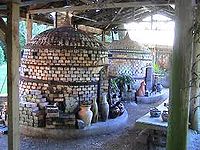Kilns
A kiln is a type of high temperature oven used in a variety of processes, from the roasting of hops for beer to the manufacture of ceramics. It may also be called a furnace, depending on the industry in which it is used in. Most people differentiate a kiln from an oven by the extremely high temperatures which it reaches. These temperatures require the structure to be lined with specialized material that will not fail in heat that may exceed thousands of degrees.
Materials put in a kiln may be dried, hardened, or directly burned, depending on how much they are heated. Many grains are kiln dried, as is timber, which is classically dried to cure it. Other materials such as ceramics may be hardened with the use of a high temperature oven, which actually changes the chemical composition of the clay. It may also be used to burn things, reducing wood to charcoal, for example. Many specialized kilns are designed to meet a particular need. The designs factor in the ways in which they will be used. A ceramic kiln, for example, usually has a series of adjustable shelves to fit ceramics on, and it will be designed to fall within a particular temperature range. Ones designed for cremation are made specially for processing human bodies, while lumber kilns are intended for use in curing lumber. Different types are built for processing limestone, or use in industrial manufacture.
Work Process
When objects are heated in a kiln, the process is called firing. Typically, the objects must be loaded very carefully before a firing, so that they use the heat in the kiln efficiently and do not explode. The oven is usually brought to temperature slowly, so that the objects inside are not shocked, and it is cooled equally slowly. Once cooled, the objects can be removed.
Natural gas is a common source of fuel for kilns, while others use electricity, propane, or even wood. Wood firing is a classical choice when artists want to practice ancient techniques of ceramics manufacture. During the firing process, the outside of the kiln may get extremely hot, so caution around the oven is advised. The temperature is monitored with the use of tools like pyrometric cones and thermometers. Since small temperature differences can have a dramatic impact on the goods being fired, it is extremely important to keep an eye on the temperature so that the firing is not ruined.
